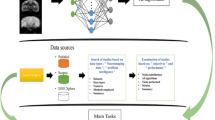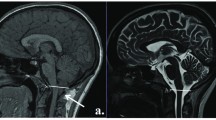Abstract
Hydrocephalus is often treated with a cerebrospinal fluid shunt (CFS) for excessive amounts of cerebrospinal fluid in the brain. However, it is very difficult to distinguish whether the ventricular enlargement is due to hydrocephalus or other causes, such as brain atrophy after brain damage and surgery. The non-trivial evaluation of the consciousness level, along with a continuous drainage test of the lumbar cistern is thus clinically important before the decision for CFS is made. We studied 32 secondary mild hydrocephalus patients with different consciousness levels, who received T1 and diffusion tensor imaging magnetic resonance scans before and after lumbar cerebrospinal fluid drainage. We applied a novel machine-learning method to find the most discriminative features from the multi-modal neuroimages. Then, we built a regression model to regress the JFK Coma Recovery Scale-Revised (CRS-R) scores to quantify the level of consciousness. The experimental results showed that our method not only approximated the CRS-R scores but also tracked the temporal changes in individual patients. The regression model has high potential for the evaluation of consciousness in clinical practice.





Similar content being viewed by others
References
Chari A, Czosnyka M, Richards HK, Pickard JD, Czosnyka ZH. Hydrocephalus shunt technology: 20 years of experience from the Cambridge Shunt Evaluation Laboratory. J Neurosurg 2014, 120: 697–707.
Del Bigio MR. Neuropathology and structural changes in hydrocephalus. Dev Disabil Res Rev 2010, 16: 16–22.
Daou B, Klinge P, Tjoumakaris S, Rosenwasser RH, Jabbour P. Revisiting secondary normal pressure hydrocephalus: does it exist? A review. Neurosurg Focus 2016, 41: E6.
Governale LS, Fein N, Logsdon J, Black PM. Techniques and complications of external lumbar drainage for normal pressure hydrocephalus. Neurosurgery 2008, 63: 379–384.
Marmarou A, Young HF, Aygok GA, Sawauchi S, Tsuji O, Yamamoto T, et al. Diagnosis and management of idiopathic normal-pressure hydrocephalus: a prospective study in 151 patients. J Neurosurg 2005, 102: 987–997.
Giacino JT, Kalmar K, Whyte J. The JFK Coma Recovery Scale-Revised: measurement characteristics and diagnostic utility. Arch Phys Med Rehabil 2004, 85: 2020–2029.
Noirhomme Q, Brecheisen R, Lesenfants D, Antonopoulos G, Laureys S. “Look at my classifier’s result”: Disentangling unresponsive from (minimally) conscious patients. Neuroimage 2017, 145: 288–303.
Osuka S, Matsushita A, Yamamoto T, Saotome K, Isobe T, Nagatomo Y, et al. Evaluation of ventriculomegaly using diffusion tensor imaging: correlations with chronic hydrocephalus and atrophy. J Neurosurg 2010, 112: 832–839.
Seo SW, Kim ST, Lee JI, Nam DH. Differential diagnosis of idiopathic normal pressure hydrocephalus from other dementias. AJNR Am J Neuroradiol 2011, 32: 1496–1503.
Khoo HM, Kishima H, Tani N, Oshino S, Maruo T, Hosomi K, et al. Default mode network connectivity in patients with idiopathic normal pressure hydrocephalus. J Neurosurg 2016, 124: 350–358.
Hoza D, Vlasak A, Horinek D, Sames M, Alfieri A. DTI-MRI biomarkers in the search for normal pressure hydrocephalus aetiology: a review. Neurosurg Rev 2015, 38: 239–244; discussion 244.
Wu X, Zhang J, Cui Z, Tang W, Shao C, Hu J, et al. White matter deficits underlying the impaired consciousness level in patients with disorders of consciousness. Neurosci Bull 2018, 34: 668–678.
Di Perri C, Thibaut A, Heine L, Soddu A, Demertzi A, Laureys S. Measuring consciousness in coma and related states. World J Radiol 2014, 6: 589.
Fernández-Espejo D, Bekinschtein T, Monti MM, Pickard JD, Junque C, Coleman MR, et al. Diffusion weighted imaging distinguishes the vegetative state from the minimally conscious state. Neuroimage 2011, 54: 103–112.
Jenkinson M, Bannister P, Brady M, Smith S. Improved optimization for the robust and accurate linear registration and motion correction of brain images. Neuroimage 2002, 17: 825–841.
Tzourio-Mazoyer N, Landeau B, Papathanassiou D, Crivello F, Etard O, Delcroix N, et al. Automated anatomical labeling of activations in SPM using a macroscopic anatomical parcellation of the MNI MRI single-subject brain. Neuroimage 2002, 15: 273–289.
Wakana S, Jiang H, Nagae-Poetscher LM, Van Zijl PC, Mori S. Fiber tract–based atlas of human white matter anatomy 1. Radiology 2004, 230: 77–87.
Yeh FC, Verstynen TD, Wang Y, Fernández-Miranda JC, Tseng WY. Deterministic diffusion fiber tracking improved by quantitative anisotropy. PLoS One 2013, 8.
Messe A, Caplain S, Paradot G, Garrigue D, Mineo JF, Soto Ares G, et al. Diffusion tensor imaging and white matter lesions at the subacute stage in mild traumatic brain injury with persistent neurobehavioral impairment. Hum Brain Mapp 2011, 32: 999–1011.
Perlbarg V, Puybasset L, Tollard E, Lehericy S, Benali H, Galanaud D. Relation between brain lesion location and clinical outcome in patients with severe traumatic brain injury: a diffusion tensor imaging study using voxel-based approaches. Hum Brain Mapp 2009, 30: 3924–3933.
Haufe S, Meinecke F, Görgen K, Dähne S, Haynes JD, Blankertz B, et al. On the interpretation of weight vectors of linear models in multivariate neuroimaging. Neuroimage 2014, 87: 96–110.
Kia SM, Vega Pons S, Weisz N, Passerini A. Interpretability of multivariate brain maps in linear brain decoding: Definition, and heuristic quantification in multivariate analysis of MEG time-locked effects. Front Neurosci 2017, 10: 619.
Weichwald S, Meyer T, Özdenizci O, Schölkopf B, Ball T, Grosse-Wentrup M. Causal interpretation rules for encoding and decoding models in neuroimaging. Neuroimage 2015, 110: 48–59.
Tolosi L, Lengauer T. Classification with correlated features: unreliability of feature ranking and solutions. Bioinformatics 2011, 27: 1986–1994.
Lutkenhoff ES, Chiang J, Tshibanda L, Kamau E, Kirsch M, Pickard JD, et al. Thalamic and extrathalamic mechanisms of consciousness after severe brain injury. Ann Neurol 2015, 78: 68–76.
Zeman A. Consciousness. Brain 2001, 124: 1263–1289.
Wu X, Zou Q, Hu J, Tang W, Mao Y, Gao L, et al. Intrinsic functional connectivity patterns predict consciousness level and recovery outcome in acquired brain injury. J Neurosci 2015, 35: 12932–12946.
Laureys S, Owen AM, Schiff ND. Brain function in coma, vegetative state, and related disorders. Lancet Neurol 2004, 3: 537–546.
Greitz D. Radiological assessment of hydrocephalus: new theories and implications for therapy. Neurosurg Rev 2004, 27: 145–165; discussion 166–147.
Qin P, Wu X, Huang Z, Duncan NW, Tang W, Wolff A, et al. How are different neural networks related to consciousness? Ann Neurol 2015, 78: 594–605.
Levin HS, Wilde EA, Chu Z, Yallampalli R, Hanten GR, Li X, et al. Diffusion tensor imaging in relation to cognitive and functional outcome of traumatic brain injury in children. J Head Trauma Rehabil 2008, 23: 197–208.
Zhao C, Li Y, Cao W, Xiang K, Zhang H, Yang J, et al. Diffusion tensor imaging detects early brain microstructure changes before and after ventriculoperitoneal shunt in children with high intracranial pressure hydrocephalus. Medicine (Baltimore) 2016, 95: e5063.
Assaf Y, Ben-Sira L, Constantini S, Chang LC, Beni-Adani L. Diffusion tensor imaging in hydrocephalus: initial experience. AJNR Am J Neuroradiol 2006, 27: 1717–1724.
Cavaliere C, Aiello M, Di Perri C, Fernandez-Espejo D, Owen AM, Soddu A. Diffusion tensor imaging and white matter abnormalities in patients with disorders of consciousness. Front Hum Neurosci 2014, 8: 1028.
Hulkower M, Poliak D, Rosenbaum S, Zimmerman M, Lipton ML. A decade of DTI in traumatic brain injury: 10 years and 100 articles later. AJNR Am J Neuroradiol 2013, 34: 2064–2074.
Zhang L, Wang Q, Gao Y, Li H, Wu G, Shen D. Concatenated spatially-localized random forests for hippocampus labeling in adult and infant MR brain images. Neurocomputing 2017, 229: 3–12.
Zhang L, Wang Q, Gao Y, Wu G, Shen D. Automatic labeling of MR brain images by hierarchical learning of atlas forests. Med Phys 2016, 43: 1175–1186.
Bai L, Rossi L, Cui L, Cheng J, Hancock ER. A quantum-inspired similarity measure for the analysis of complete weighted graphs. IEEE Trans Cybern 2019.
Bai L, Hancock ER. Fast depth-based subgraph kernels for unattributed graphs. Pattern Recognit 2016, 50: 233–245.
Acknowledgements
This work was supported by the National Natural Science Foundation of China (81571025 and 81702461), the National Key Research and Development Program of China (2018YFC0116400), the International Cooperation Project from Shanghai Science Foundation (18410711300), Shanghai Science and Technology Development Funds (16JC1420100), the Shanghai Sailing Program (17YF1426600), STCSM (19QC1400600, 17411953300), the Shanghai Pujiang Program (19PJ1406800), the Shanghai Municipal Science and Technology Major Project (No.2018SHZDZX01) and ZJlab, and the Interdisciplinary Program of Shanghai Jiao Tong University.
Author information
Authors and Affiliations
Corresponding authors
Ethics declarations
Conflicts of interest
The authors claim that there are no conflicts of interest.
Rights and permissions
About this article
Cite this article
Huo, J., Qi, Z., Chen, S. et al. Neuroimage-Based Consciousness Evaluation of Patients with Secondary Doubtful Hydrocephalus Before and After Lumbar Drainage. Neurosci. Bull. 36, 985–996 (2020). https://doi.org/10.1007/s12264-020-00542-2
Received:
Accepted:
Published:
Issue Date:
DOI: https://doi.org/10.1007/s12264-020-00542-2




